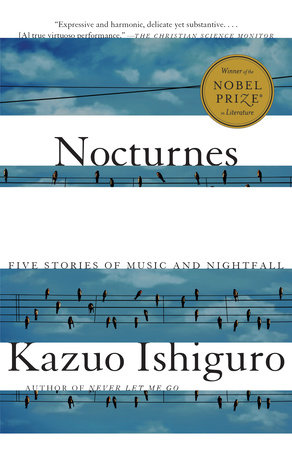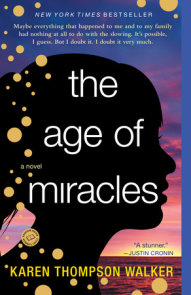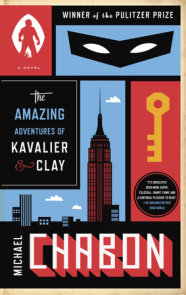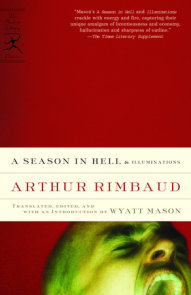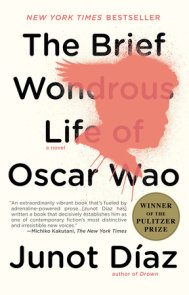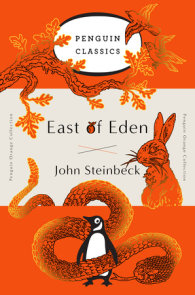READERS GUIDE
“In both craft and substance Nocturnes reveals a master at work.” —The Seattle TimesThe questions, discussion topics, and reading list that follow are intended to enhance your reading group’s discussion of Nocturnes, the lovely, elegiac collection of stories by Booker Prize winner Kazuo Ishiguro.
Introduction
One of the most celebrated writers of our time gives us his first cycle of short fiction: five brilliantly etched, interconnected stories in which music is a vivid and essential character.Here is a fragile, once famous singer, turning his back on the one thing he loves; a music junky with little else to offer his friends but opinion; a songwriter who inadvertently breaks up a marriage; a jazz musician who thinks the answer to his career lies in changing his physical appearance; and a young cellist whose tutor has devised a remarkable way to foster his talent.
Passion or necessity—or the often uneasy combination of the two—determines the place of music in each of these lives. And, in one way or another, music delivers each of them to an epiphany: sometimes comic, sometimes tragic, sometimes eluding their grasp.
An exploration of love, need, and the ineluctable force of the past, Nocturnes reveals these individuals to us with extraordinary precision and subtlety, and with the arresting psychological and emotional detail that has marked all of Kazuo Ishiguro’s acclaimed works of fiction.
Questions and Topics for Discussion
1. General Questions:
• In each story, at least one character is deluding him- or herself. Who is the worst offender? How does Ishiguro signal this to the reader?
• All five stories are told in first-person narration. Which of the narrators is most trustworthy, and why?
• How does Ishiguro use humor, even farce, to illuminate his characters’ psyches?
• Webster defines nocturne as “a work of art dealing with evening or night; especially: a dreamy pensive composition for the piano.” How does each story qualify as a nocturne? How does Ishiguro use night as a metaphor?
2. “Crooner”:
• Why is Janeck’s nationality important? Why does Tony think it’s important? How does Ishiguro use Eastern vs. Western attitudes to further the story?
• On page 12, Janeck says, “In fact it was so sweet an idea it almost, but not quite made me forget the scene I’d just witnessed between them. What I mean is, even at that stage, I knew deep down that things wouldn’t be as straightforward as he was making out.” Why does Ishiguro offer this bit of foreshadowing? What does it make you think as you’re reading?
• How would you describe Tony and Lindy’s relationship? How do you think Lindy would describe it?
3. “Come Rain or Come Shine”:
• On page 38, Ray says, “We were especially pleased when we found a recording—like Ray Charles singing ‘Come Rain or Come Shine’—where the words themselves were happy, but the interpretation was pure heartbreak.” What does this tell us about Ray and Emily? How does it come into play later in the story?
• Do you think Ray is really as much of a loser as Charlie and Emily believe him to be? How does your perception of him change over the course of the story?
• What does Ray’s trashing of the apartment symbolize? How does Sarah Vaughan smooth things over?
4. “Malvern Hills”:
• “I quickly discovered that breakfast at the cafe was a nightmare, with customers wanting eggs done this way, toast like that, everything getting overcooked. So I made a point of never appearing until around eleven” (page 93). What does this tell us about the narrator? Who’s doing whom a favor here?
• What do you think of Tilo and Sonja? Are they artists who have suffered for their music? Or does their relationship with their son hint at something different?
• Sonja says to the narrator on page 122, “As it is, life will bring enough disappointments. If on top, you have such dreams as this . . . But I should not say these things. I am not a good example to you. Besides, I can see you are much more like Tilo.” What do you think the narrator learns from his encounters with Sonja and Tilo? Do you imagine he’ll press on with his music?
5. “Nocturne”
• Why do you think Ishiguro chose to reintroduce Lindy Gardner? How does reading this story change your understanding of “Crooner”?
• “If there was one figure who epitomised for me everything that was shallow and sickening about the world, it was Lindy Gardner: a person with negligible talent . . . who’s managed all the same to become famous” (page 137). In what ways is this idea connected to the other stories in the collection? How much does talent matter in Ishiguro’s world?
• How does being wrapped in bandages and hidden away from the world affect Steve and Lindy’s behavior? Do you think things might have gone differently if their faces were exposed?
6. “Cellists”
• How does Eloise influence, and seemingly improve, Tibor’s playing? What power does she hold?
• Eloise says, “You have to understand, I am a virtuoso. But I’m one who’s yet to be unwrapped” (page 212). Why is she convinced of this? Do you believe she’s a virtuoso? Does Tibor?
• What similarities can you find among Eloise, Lindy, and Sonja? Does Emily fit into this vein, too?
(For a complete list of available reading group guides, and to sign up for the Reading Group Center enewsletter, visit www.readinggroupcenter.com)







